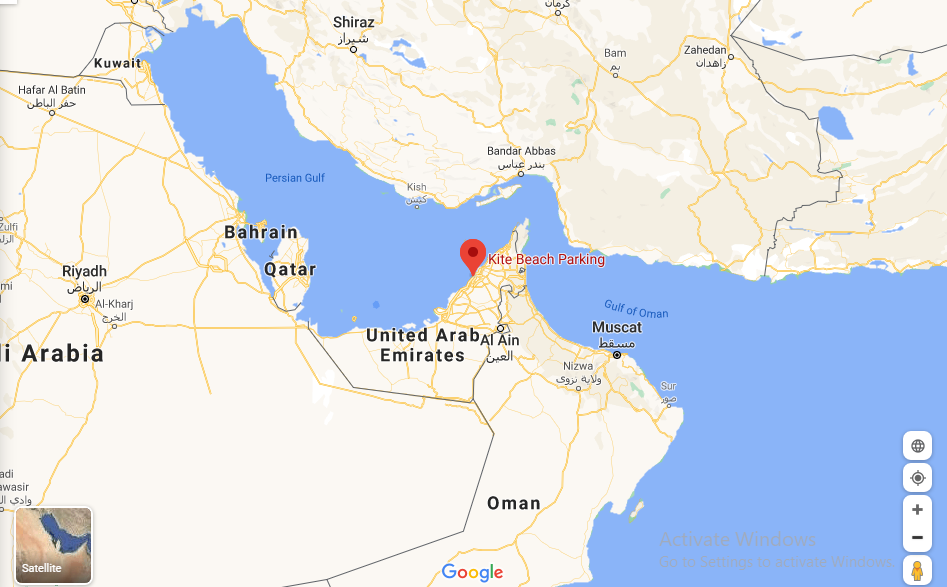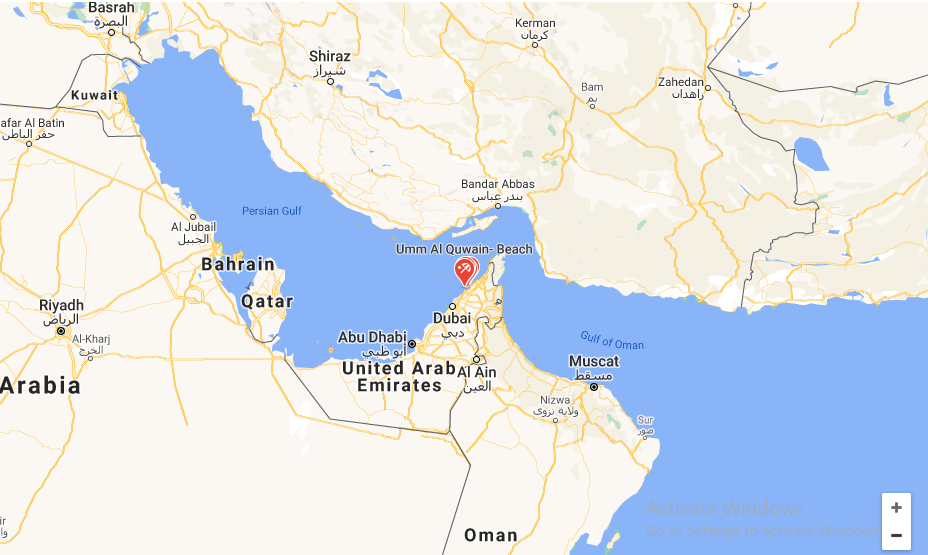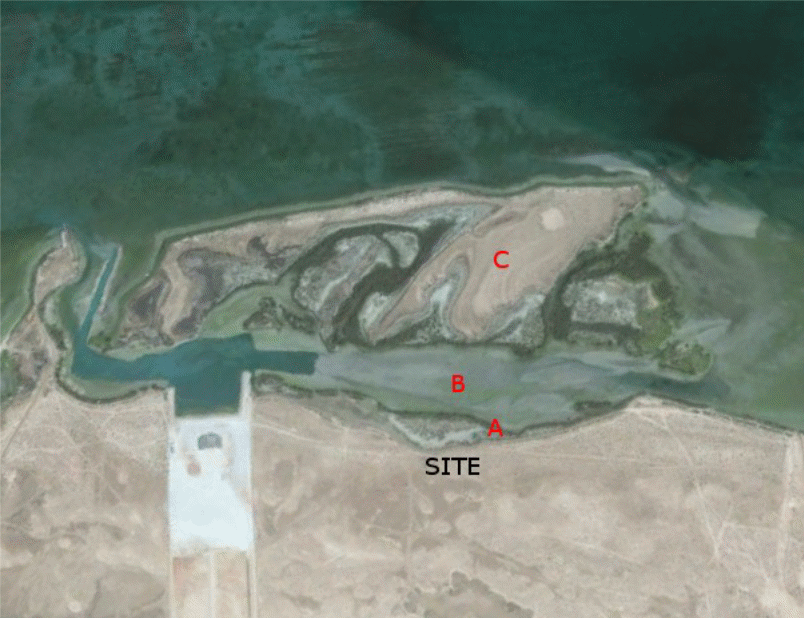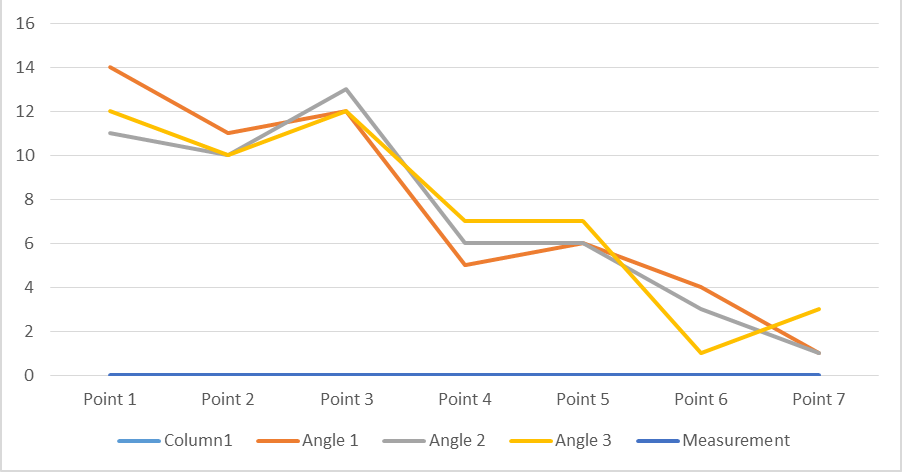Executive Summary
Fieldwork and Geographic Context
The United Arab Emirates has splendid beaches along the Persian Gulf. This study focuses on two adjacent ones: Kite Beach in Dubai and Umm Al Quwain (UAQ) Beach in the eponymous city. As shown in Figures I(a) and (b), on the overall map of the United Arab Emirates (UAE), the beaches are connected, a fact that simplified the author’s work; it made it easy to trace the ranging of physical features on the coastline. Notably, the study’s objective was to examine environmental processes and coastal management practices in the sites. The belief that each area has a basic structure and a regional specificity served as the exploration’s driving force.
The physical processes studied included erosion, wave action, deposition, coastal landforms, beach shape, and longshore drift. Authorities implement coastal management approaches, including soft and hard engineering, policies, and natural processes, to mitigate physical processes. The researcher carried out the study on the identified two sites because they could access them with ease. The author also originated two hypotheses, one for each of the identified areas, as follows:
- Hypothesis 1: There are prominent/noticeable physical processes and coastal management activities in Kite Beach.
- Hypothesis 2: There are prominent/noticeable physical processes and coastal management activities in Umm Al Quwain Beach.


Methods of Investigation
The author investigated physical processes and coastal management practices on the two sites using observation and measurements. The author observed the coastlines for signs of erosion like hydraulic action, corrosion, abrasion, attrition, and solution. For evidence of deposition, the author observed and recorded wave refraction. For wave action, the researcher observed and measured energy reflection and dissipation.
Lastly, for longshore drift, the researcher observed sediment transportation. For evidence of hard engineering as a coastal management technique, the author looked for sea walls, ripraps, groynes, gabions, revetments, and tetrapod. For proof of soft engineering, the author observed the coastlines for planted vegetation and beach replenishment.
The author also looked for and recorded information about beach signage, access restriction, and managed retreats as evidence of policy as a coastal management technique. Lastly, the author also observed the beaches for signs of natural processes like the presence of mangroves and the absence of human activity. The justification for using observation and measurement is that they are the most natural ways of comprehending coastal geography.
Quality and Treatment of Collected Information
The data collected by the author reveal little evidence of physical processes like erosion and deposition along the UAE coastline. However, because these processes are unavoidable, the researcher needed a significantly large amount of time to observe and record them. Notably, previous data about the erosion rate along the UAE beaches suggest that the ocean consumes about 50 meters of land every two years.
At this rate, most of the facilities next to the beaches, including homes, resorts, and restaurants, are vulnerable to destruction as maritime forces edge closer. Expectedly, erosion in the identified sites occurs through corrosion (solution), attrition, hydraulic action, and corrasion (abrasion). Although the author did not record any meaningful erosion process during the study period, they observed irregularity in the beach shape and gradient, a pointer of past erosion over thousands of years.
Regarding management activities, the development of the coastal area in the UAE started in the 1970s and has been accelerating. Part of the reason for this growth has been a population increase and a rise in international tourists’ numbers. The development has included various offshore development schemes, including Palm Jumeirah, Palm Jebel Ali, The World, Jebel Ali Port (expansion), Palm Deira, and Deira Sea Corniche.
For these developments, which contain famous amenities like the notable Burj Al Arab Hotel, the UAE coastline, particularly around Dubai, is a popular tourist destination. Yearly, millions of people from all over the world flaunt the region for enjoyment. In addition to that, the local population is rising fast, and people are settling close to the Persian Gulf rather than further inland, where there is nothing more than expansive deserts and bare lands.
Therefore, the coastal area is experiencing a negative impact on natural processes like erosion and human activity. Local authorities have resorted to coastal management to prevent further degradation of the coastline, primarily due to rising human activity and artificial islands’ presence in the area.
Conclusion
The collected data confirms the first hypothesis but not the second one. In other words, the author observed significant coastal management activities on the two beaches and little evidence of erosion. The author could not see and measure any significant decline and other natural environmental processes because they take a long time to occur. However, there is an irregularity in the coastline’s shape and gradient, suggesting previous erosion over the years.
Additionally, the author observed incredible coastal management activities on the two beaches. These findings imply that the UAE is actively managing its beaches because it is aware of the rising impact of human activity in the area. The negative human impact is due to increases in the local population and tourists visiting the region annually. Coastal management practices are a deliberate effort by local authorities to save the beaches by minimizing and ultimately eradicating negative human impact.
Fieldwork and Geographic Context
The quality of data collected varies depending on the field worker. Experience is vital in ensuring that mistakes are avoided. Fieldwork’s success depends on the researcher’s curiosity and zeal to gather more data (Delamont & Atkinson 152). However, when human beings are subject during a study, there are protocols to follow, which reduce the acquisition of theoretical explanations when dealing with cultural practices (Delamont & Atkinson 152). Most of the data is qualitative, with the analysis methods used being thematic or narrative.
Background and Socio-Economic Information
The research attempts to find out what coastal management strategies and physical processes are on the coastlines in the UAE. The countries surrounding the Persian Gulf have a unique marine ecosystem that is at risk due to anthropogenic impacts. They are rapidly growing in population, with urbanization being a threat to the coastal area.
The ecosystem in the Gulf is unique with tourism assets, fisheries, and oil reserves. However, increasing pressure, overfishing, overpopulation, pollution, and destruction of habitat create the risk for the ecosystem loss in the wake of climatic change (Gulseven 208). UAE has been undergoing dramatic constructions in the past two decades. Lamine et al. are concerned about significant climate changes and the endangerment of species and the natural ecosystem (2972). The changes were detected in the rapid rise of humidity and wind speed.
There are multiple reasons affecting the coastal issues, and it is necessary to consider them all for an effective management. The United Arab Emirates is located between Saudi Arabia and Oman, which is mostly arid and semi-arid land. The majority of the country experiences high temperatures and infrequent precipitation (Lamine et al. 2979.). The changes detected currently include a rapid rise in sea level, scarcity of water, and drought, worsening due to global warming (Lamine et al., 2983).
Other factors are high carbon dioxide emissions harmful to the ozone layer as energy consumption from the ecosystem is high. Significant environmental problems affecting the country are air pollution, loss of wildlife, and land pollution. The government is among the leading oil and gas producers in the world hence utilizing available natural resources.
Effects of Climate Change
Climatic change globally has become a merging issue with the world’s population increasing, posing a threat to the natural ecosystem with flora and fauna. The UAE investigated the effects of rising emissions of carbon dioxide in 2010. Dust storms are common in desert climate regions like the UAE. Dust storms are associated with high temperature, less precipitation, and increasing winds (“Climate Change and Energy Dynamics” 212).
The changing wind patterns in the Persian Gulf moving temporary soil and mineral particles. Second, rising sea levels associated with the melting of polar ice, leading to land loss and overpopulation (Pickett et al. 259). Thus, climate change is a severe issue relevant for multiple countries of the world including UAE.
However, the coastal region is facing conservation challenges affecting the marine ecosystem. First, the buildings near the coast affect its structure and change its condition. The depressions have since turned to inlets channeling wastewater to the marine environment (Pickett et al. 258). Moreover, the exposure of beaches without regulations has resulted in the pollution that reduced fish population affecting fisheries (Pickett et al. 263).
The ocean walls are affected negatively with most mangrove forests being harvested by farmers to act as fodder to cattle. As the ocean water volume increase, the temperatures are fluctuating as a result of global warming (Ben-Romdhane et al. 52). Few policies and rules have been introduced in beaches such as do not litter, but there is a need for stronger policies with repercussions to offenders against the environment.
In the same manner, a few techniques were introduced to protect the marine environment. Hard engineering involves the creation of structures to reduce damage made on a topography—for instance, the installation of gabions in landscapes with deep Galleys to regulate or control water movement. Soft engineering involves the planting of vegetation like trees to replenish the appearance of the beach. Policymaking is the imposing of restrictive access to services, places, and products like trees to protect an ecosystem.
The UAE coastline has witnessed high growth in population density in the last five years. The construction of islands and buildings resulted in a rapid negative change in climate conditions. Urbanization has also contributed to the invasion of species which are a negative effect on the biodiversity as they displace native species (Shibieka et al. 13).
Increased use of energy also contributed to high carbon emissions to the atmosphere. Carbon is harmful to the ozone and causes acid rain and the reduction in the size of the ozone layer (Shibieka et al. 19). Nevertheless, water sources are scarce as most water is salty and the nature of UAE is an arid, semi-arid area.
Overfishing is also a threat to the marine ecosystem as fish deplete in number. In some beaches, small channels of inlets with waste are released to the ocean killing fauna (Bazrkar et al. 641). Rapid population growth led to the increase in a waste generation which sometimes is released to the sea. Lastly, air pollution and land degeneration are also challenges affecting the United Arab Emirates coastline.
Hypotheses
- Hypothesis 1: There are prominent/noticeable physical processes and coastal management activities in Kite Beach.
- Hypothesis 2: There are prominent/noticeable physical processes and coastal management activities in Umm Al Quwain Beach.
Method of Investigation
Based on the hypotheses, the research methods used were observation and measurement. A site visit was made to learn more about climate change. The purpose of the investigation is to understand changes in the area by measuring the depth of the sand. To do this, it was necessary to make different holes in the sand with the poles, measure them with the measuring tape, and record them in a table and chart for at least 3 times. Another method was using the degree measurer to check the wind patterns. Observations were also made to understand approaches taken to protect the beach. Tools used included poles, tape measure, degree measurer, and field book to record observations and findings. Data was collected in field books with a slight difference in the cognitive reasoning and interpretation of comments.
Methods Carried Out That Relate to the Hypothesis
Collected comparative data helped make conclusive remarks by comparing the durability and effectiveness of tactics used to protect the coastline. It is necessary for choosing the best tactics and its further development. The data comprises quantitative data as shown in Table 1. It will involve measurements of different points around the given area for comparison.

Data Analysis
Data Representation

Table 1. Comparative Data on Climate Change in UAE.
Text Analysis
Soil erosion is a significant challenge with the depressions and galleys formation that create wave cut. The number of individuals accessing the recreational facility is limited, with rules and signage giving guidelines on protecting the beach. The coastal region is now an urban center as recreational facilities are developing along the beach (Yilmaz and Shabib 60).
Despite being a restricted area, the beach has a litter, and the number of amenities present is few. The results were analyzed using statistics and confirmed that the hypothesis was true. The value of probability was one indicating a high chance of infectivity of coastal protection techniques (Bazrkar et al. 627). Water levels are rapidly increasing and keep fluctuating in different depths in the sand.
The United Arab Emirates coastal region is currently endangered as most of the ecosystem has been tampered by humans and nature. Environmental agencies are scarce, and policies are not strict, giving citizens a leeway to depreciate the environment (Bazrkar et al. 619-655). Climate change is evident in the data collected, with most urbanized areas and sparsely populated areas having different water levels. The results confirm that the hypothesis is correct; hence management techniques to protect the coastal region are not sustainable.
Evaluation
The research was organized with straightforward and understandable data collection. The sites were easily accessible, and the conclusive information was given for assessment. However, recreational facilities were challenging to access as the number of people in them were limited. Moreover, some of the information given was based on people’s opinions without evidence to confirm facts from fiction. Additionally, the field trip was short and should have involved various comparisons between beaches and management. These comparisons are vital since management techniques are unique to different coastal topography and ecosystems.
Conclusion
The rapid growth of population and urbanization is a major enemy to the coastal ecosystem. Over the past two decades, the anthropogenic constructions on land and sea have caused destruction and rapid changes affecting marine life and the environment (Yilmaz and Shabib 60). While leaders attempt to improve citizens’ livelihoods, the environment should be a pivotal aspect to consider during the creation and implementation of policies.
A team of experts should form an independent association to direct leaders on ways to protect the coastal ecosystem with strict consequences to citizens who violate. The amount of waste disposed of in the sea should be channelled to eco-friendly disposal methods that protect marine life (Yilmaz and Shabib 60). Mangrove forests should be protected from farmers. However, even now, there are some positive tendencies. For instance, the use of nuclear energy has already helped in the reduction of carbon emitted to the atmosphere.
Works Cited
Bazrkar, Mohammad H., et al. “Urbanization and Climate Change.” Handbook of Climate Change Adaptation, edited by Leal Filho, Walter, 2015, pp. 619-655.
Ben-Romdhane, H., et al. “Coral reefs of Abu Dhabi, United Arab Emirates: Analysis of Management Approaches in Light of International Best Practices and a Changing Climate.” Frontiers in Marine Science, vol. 7, 2020. Web.
Climate Change and Energy Dynamics in the Middle East: Modeling and Simulation-Based Solutions, edited by Qudrat-Ullah, Hassan, and Aymen Kayal, Springer, 2019.
Delamont, Sara, & Paul Atkinson. Ethnographic Fieldwork. SAGE Research Methods Foundations, 2020.
Houghton, John. Global Warming. Cambridge University Press, 2015.
Gulseven, O. “Measuring Achievements towards SDG 14, Life below Water, in the United Arab Emirates.” Marine Policy, vol. 117, 2020, p. 103-972. Web.
Lamine, E. B., et al. “Identifying Coastal and Marine Priority Areas for Conservation in the United Arab Emirates.” Biodiversity and Conservation, vol. 29, no. 9-10, 2020, pp. 2967-2983. Web.
Pickett, Nathaniel R., et al. “Science, Technology, and Society Approaches to Fieldwork in Geography.” The Professional Geographer, vol. 72, no. 2, 2019, pp. 253-263.
Shibieka, Amna, et al. “Exploring Challenges of Adopting Sustainability Assessment: Methods in UAE – Perspectives of Project Professionals.” 5thInternational Conference on Sustainable Construction Materials and Technologies, 2019. Web.
UAE. “Climate change.” Ministry of Foreign Affairs and International Cooperation and UAE Embassy in the US. 2020. Web.
Yilmaz, A. G., and A. G. Shabib. “Rainfall and Air Temperature Projections for Sharjah City, United Arab Emirates.” International Journal of Water, vol. 13, no. 1, 2019, p. 60. Web.